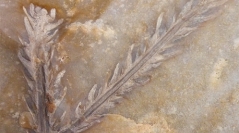

 Comptes Rendus Palevol
17 (7) - Pages 435-442
Comptes Rendus Palevol
17 (7) - Pages 435-442Three new localities yielding fossiliferous flints are reported from the Châtellerault area (Vienne, western France). They include one archaeological site (La Grande Vallée) and two zones with alterite deposits (L’Aunas and Les Bariollières). Broken surfaces of flint nodules show co-occurrence of marine invertebrates such as bryozoans, echinoids (Micraster Agassiz, Orthopsis Cotteau), gastropods (Acteonella d’Orbigny), rudists, and sponges. The association of Acteonella, Micraster and Orthopsis confirms the Turonian age (Upper Cretaceous) of the fossil assemblage. The marine invertebrates co-occur with plant macroremains including fragments of conifer leafy axes such as Brachyphyllum? Brongn., Frenelopsis (Schenk) emend. J. Watson and Geinitzia Endl., as well as fragments of angiosperm leaves. Plant remains are preserved as siliceous permineralizations, showing the gross morphology and all tissues in three dimensions. The fossil assemblage suggests that sediments were deposited proximally along the shoreline in shallow environment influenced by both continental and marine inputs. This coastal area was close to a conifer-dominated forest ecosystem, Geinitzia being probably one of the main components of the flora.
Plants, Conifers, Angiosperms, Marine invertebrates, Flints, Upper Cretaceous, Vienne